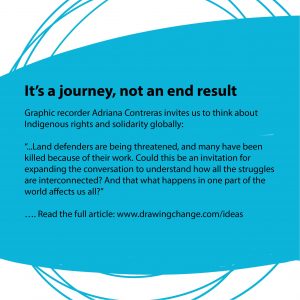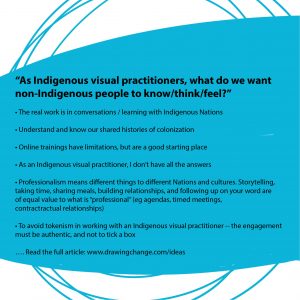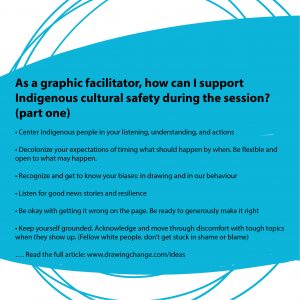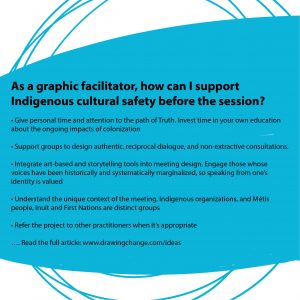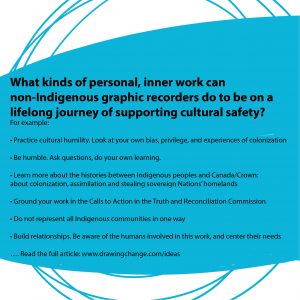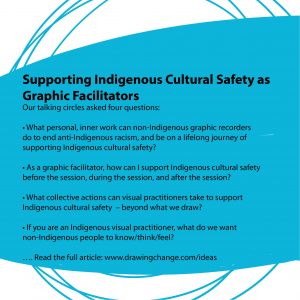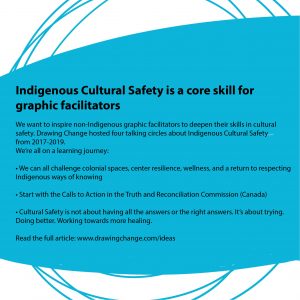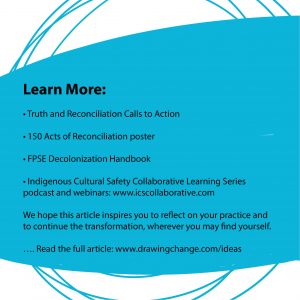
Indigenous Cultural Safety is a core skill for graphic facilitators
Sharing wisdom from talking circles at Drawing Change workshops (2017-2019)
 Graphic facilitators in Canada and the United States need to have skills in Indigenous cultural safety to do our work well. Since 2017, Drawing Change visual facilitation training workshops (hosted on unceded Musqueam, Tsleil-Waututh, and Squamish homelands currently known as Vancouver, Canada) have included a talking circle about graphic facilitation and Indigenous cultural safety. After hosting four talking circles, here are collective insights from participants and facilitators, to help continue the conversation. This sharing is aimed at non-Indigenous graphic recorders. It’s not about having all the answers or the right answers. It’s about trying. Doing better. The joy that comes from healing. Finding support to keep trying, and doing better.
Graphic facilitators in Canada and the United States need to have skills in Indigenous cultural safety to do our work well. Since 2017, Drawing Change visual facilitation training workshops (hosted on unceded Musqueam, Tsleil-Waututh, and Squamish homelands currently known as Vancouver, Canada) have included a talking circle about graphic facilitation and Indigenous cultural safety. After hosting four talking circles, here are collective insights from participants and facilitators, to help continue the conversation. This sharing is aimed at non-Indigenous graphic recorders. It’s not about having all the answers or the right answers. It’s about trying. Doing better. The joy that comes from healing. Finding support to keep trying, and doing better.
May we all share in the vision of a potential future that centres resilience, wellness, abundance, and a return to respecting Indigenous ways of knowing.
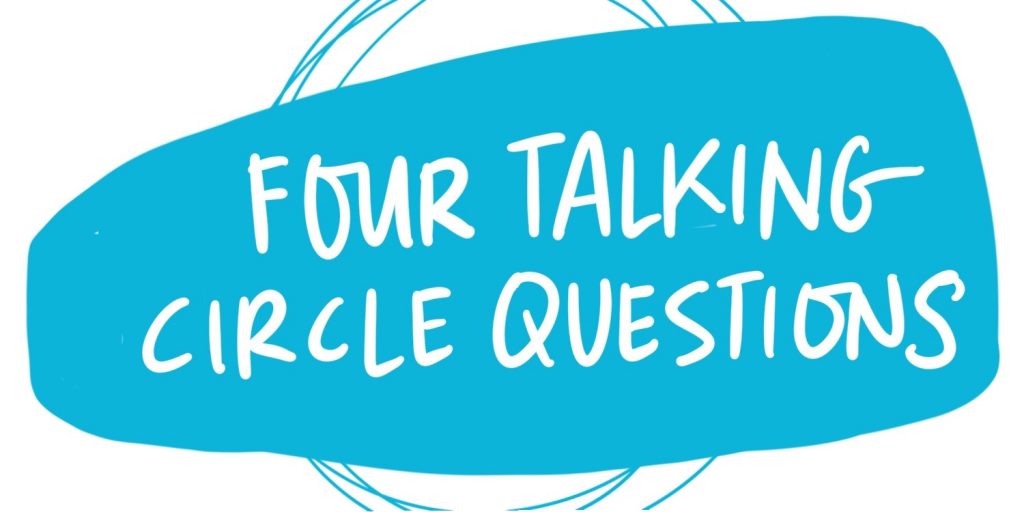 Four talking circle questions:
Four talking circle questions:
- What kinds of personal, inner work can non-Indigenous graphic recorders do to personally end anti-Indigenous racism, and be on a lifelong journey toward supporting Indigenous cultural safety?
- How can I support Indigenous cultural safety, and cultural humility, as a graphic facilitator? What actions can I personally take before the session, during the session, and after the session?
- What collective actions can visual practitioners take to support Indigenous cultural safety – beyond what we draw?
- If you are an Indigenous visual practitioner, what do we* want non-Indigenous people to know/think/feel? (this caucus was led by and for Indigenous practitioners)
First, a little bit about us and how this article came to be - and then the sharing from the workshop continues below.
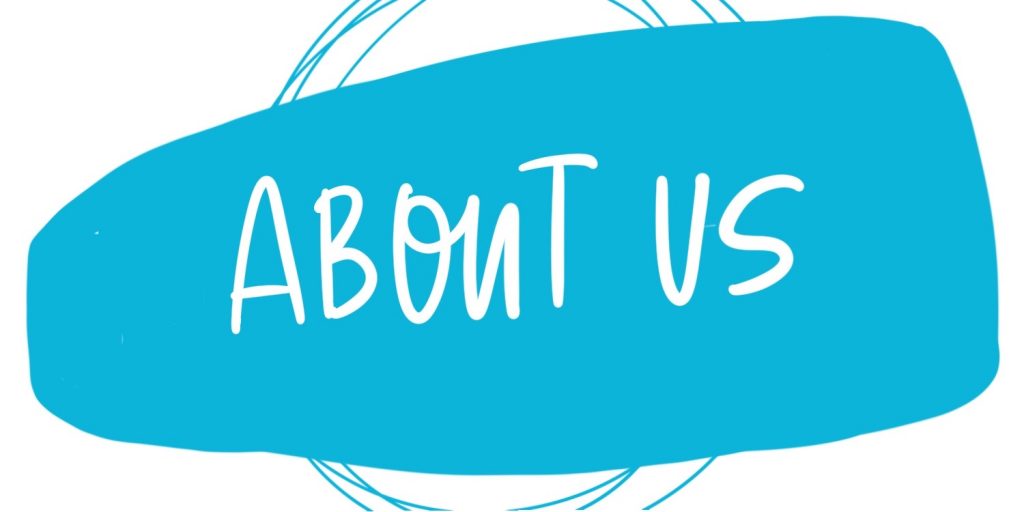 Locating Us and the Collaboration of the Talking Circles
Locating Us and the Collaboration of the Talking Circles
Since the beginning of Drawing Change, our multi-racial team of graphic recorders has worked in partnership with Indigenous organizations, for First Nations, Metis and Inuit people and Nation rebuilding, and with non-Indigenous groups who want to decolonize and implement the Truth and Reconciliation Commission Calls to Action. Because of the generosity extended to me by these many partnerships, when I began teaching Drawing Change’s visual facilitation courses in Vancouver, I realized our workshop could be different.
I’m a white settler of Italian/Scottish descent, living on unceded (stolen) Musqueam, Tsleil-Waututh, and Squamish homelands – lands with a long history of art and resilience. As a white person, I’m committed to naming and transforming colonial spaces, and working towards Indigenous cultural safety in my visual practice. I hoped co-hosting these talking circles could inspire other non-Indigenous graphic facilitators to pay attention to and deepen their skills in this area, too. But, this article isn’t a substitution for anti-Indigenous racism training/education, and it won’t tell you what to draw.
This article, as a result of the workshop talking circles, was also created collaboratively. The wisdom and work in the article below came from participants in the Drawing Change workshops over two years. Deep gratitude to all the participants, who have different backgrounds including Indigenous, migrant, Black, immigrant, mixed and white settlers. I’m grateful to the generosity of everyone who supports this conversation at Drawing Change by sharing their knowledge, including and especially Elder Lillian Howard; huge appreciation to Shawna Duncan (Cree), and Michelle Buchholz (Wet’suwet’en) who led the talking circles from 2017-2019. Co-facilitation was with Tanya Gadsby (Māori and Ukranian/Scottish), Tiaré Jung (Hawaiian and mixed ancestry), Adriana Contreras (Colombian of mixed heritage), and myself (Italian/Scottish). The October 2019 course included a smaller talking circle just for Indigenous practitioners. I typed up the harvests/notes, and am thankful to all of the facilitators, co-facilitators, and Elder Lillian, who reviewed the article collaboratively.
We hope this supports your journey towards greater Indigenous cultural safety and working with cultural humility.
1. Personal Inner Work
What kinds of personal, inner work can non-Indigenous graphic recorders do to personally end anti-Indigenous racism, and be on a lifelong journey toward more supporting Indigenous cultural safety?
- It starts with YOU. Practice cultural humility (and self reflection). Maintain a culture of curiosity. Look at your own bias, privilege, and experiences of colonization
- Ground your work in the Calls to Action in the Truth and Reconciliation. There are no shortcuts - it’s “Truth” before reconciliation
- Remember, there is not one single, pan-Indigenous experience. There is not one way to represent all Indigenous communities - but there are Indigenous Sovereign Nations across Turtle Island with a shared history of colonization. Remember there is no empty free land
- Be humble. Ask questions, do your own learning. Acknowledge personal bias. Come from the place of being a ‘beginner’
- Build relationships. Be aware of the humans involved in this work, and center their needs
- Notice, and then work to decenter whiteness in your work and practices
2. What Actions Can I Take Before, During and After

How can I support Indigenous cultural safety, and cultural humility, as a graphic facilitator? What actions can I personally take before the session, during the session, and after the session?
Before the session
- Give personal time and attention to the path of Truth. Don’t rush for “Reconciliation”, which may feel easier. Invest time in your own education about the ongoing impacts of colonization, and the histories of Indigenous-settler relations on this land. Use the Truth and Reconciliation for guidance
- Support groups to design authentic, non-extractive consultations. Use ways that enable people to have authentic, reciprocal dialogue
- Design meetings that integrate art-based and storytelling tools to engage as many people as possible whose voices have been historically and systematically marginalized, so speaking from one’s identity is valued and not expected to be ‘left at the door’
- Understand the unique context of this meeting that you’re entering. Indigenous organizations, and Métis people, Inuit and First Nations are distinct groups
- Refer the project to other practitioners when it’s appropriate
- Be humble and in service. Ask questions so you don’t assume
During the session
- Center Indigenous people in your listening, understanding, and actions
- Recognize and get to know your biases: the ones when drawing, the ones in our behaviour
- Be comfortable in your identities, and be able to socially locate yourself
- Listen for good news stories and resilience
- Keep yourself grounded. Acknowledge and move through discomfort with tough topics when they show up. (fellow white people, don’t get stuck in shame or blame)
- Be open in your body language and presence. Do not centre your own needs first (especially around anxiety around timing / agenda/ flow)
- Uphold what is sacred. If there is ceremony, or there are powerful sacred objects, draw what is appropriate to be recorded, only
- Check your language and visual language, and don’t draw idioms that have a violent anti-Indigenous history (link) or are inappropriate (you’re not “having a pow-wow”, it’s a “meeting”)
- Decolonize your expectations of timing what should happen by when. Be flexible and open to what may happen. Allow possibilities for what may emerge
- Be okay with getting it wrong on the page. Be ready to generously make it right
- Listen and draw with a holistic viewpoint. We can try and see connections around us, and look for holistic systems. Look for the complexity. In these systems, consider the connections especially to land
- If right now you are more fluent with western science and western ways of knowing, ensure you value Indigenous ways of knowing and traditional Indigenous knowledge on equal footing and represent this in your visuals
- Be open, both in words and non-verbals, so the group feels comfortable to provide guidance on imagery, symbols, and ways of visualizing in the graphics
- Invite language keepers/holders to share words or translations of the content. Language is intrinsically tied to culture, and the more we can do to help revitalize and value Indigenous languages in gatherings and our work, the better
After the session
- Ask for feedback. Was I respectful? Was there appropriate representation? Did we capture your thoughts well?
- Consider the technological needs of the group. Will images be distributed in remote locations where internet is expensive, so should files be small formats?
- Be clear on what it is agreed you may share online, and what is not. Consider OCAP principles of Ownership, Control, Access and Protection
3. What Collective Actions can Visual Practitioners Take 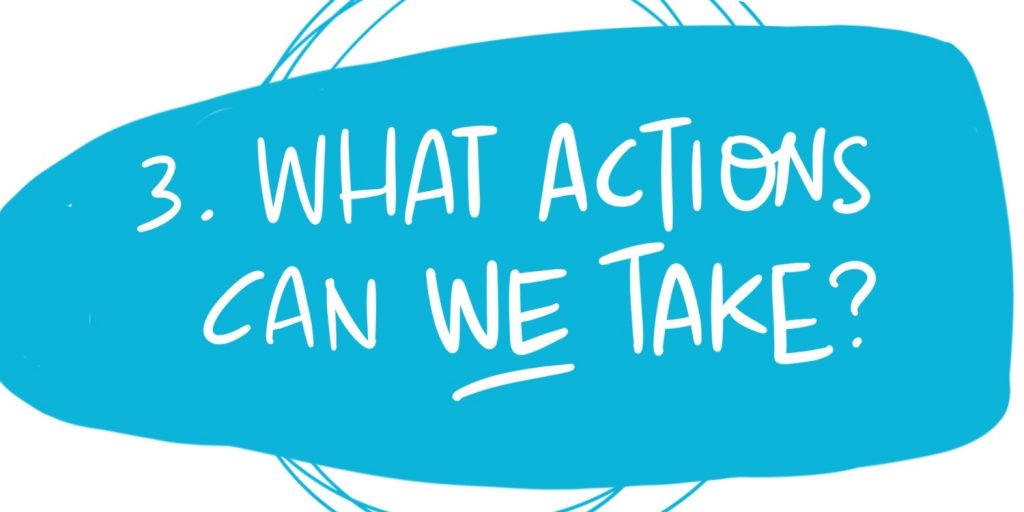
What collective actions can visual practitioners take to support Indigenous cultural safety – beyond what we draw?
- It starts with US. Be courageous. Be a changemaker
- Be an ally. Learn more about practicing cultural humility. Challenge stereotypes, unconscious bias, and prejudice. Work to end racism
- Commit to learning more about the history between Indigenous peoples and Canada/Crown. Remember colonization and assimilation have have been and continue to be about stealing sovereign Indigenous Nations’ homelands, along with their resources
- We can physically be there with community, with our bodies: show up to events, meetings, be in community beyond a one-off meeting
- Decolonizing can also be an invitation for new ways of being together. This collaboration could be storytelling and dialogue, or other ways of sharing
- Re-matriate. (In all the ways possible. For example)
- Inspire each other. Take actions for dismantling colonial practices and tell your friends and family. Check out the 150 acts of reconciliation poster
- We can be there for each other, show up for each other. In this solidarity, consider - what could it be to be in abundance together not in scarcity together. To be in solidarity, not competition
- We can look for leaders around us – especially for the people who also may not be the loudest, or most assertive, or above others in their leadership
4. As Indigenous Visual Practitioners
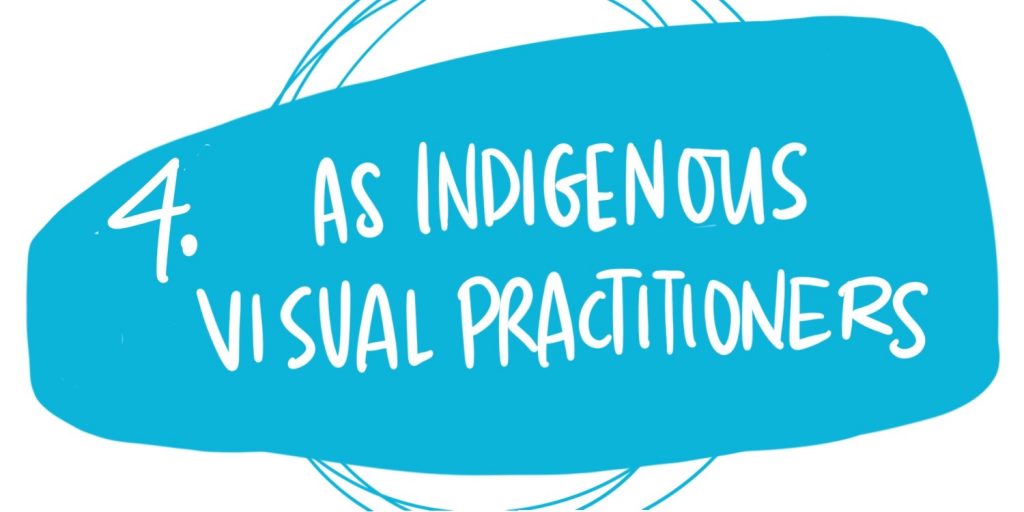
If you are an Indigenous visual practitioner, what do we want non-Indigenous people to know/think/feel? (this caucus was led by and for Indigenous practitioners)
- Online trainings have limitations, but are a good starting place
- The real work is in conversations / learning with Indigenous Nations
- You should understand and know our shared history
- As an Indigenous visual practitioner, I don’t have all the answers
- To avoid tokenism in working with an Indigenous visual practitioner -- the engagement must be authentic, and not to tick a box.
- Professionalism means different things to different Nations and cultures. Storytelling, taking time, sharing meals together, building relationships, and following up on your word are of equal value to what might be commonly considered professional (eg agendas, timed meetings, contractual relationships) in ways of work
It's a Journey - and a Global One
Indigneous cultural safety is a core skill for non-Indigenous facilitators. And, it’s a journey - not an end result.
In closing, graphic recorder Adriana Contreras invites us to think about Indigenous rights and solidarity globally:
“I have been thinking about Elder Lilian and her connection with Latin America; her visits to Columbia, Bolivia, Guatemala, Nicaragua, and Mexico are also on my mind. Land defenders are being threatened, and many have been killed because of their work. Could this be an invitation for expanding the conversation to understand how all the struggles are interconnected? And that what happens in one part of the world affects us all?”
We hope this article inspires you to reflect on your practice and to continue the transformation, wherever you may find yourself.
Resources
Truth and Reconciliation Calls to Action http://trc.ca/assets/pdf/Calls_to_Action_English2.pdf
150 Acts of Reconciliation poster https://150acts.weebly.com/
Decolonization Handbook from the Post Secondary Educators of BC: https://fpse.ca/sites/default/files/news_files/Decolonization%20Handbook.pdf
Indigenous Cultural Safety Collaborative Learning Series podcast and webinars http://www.icscollaborative.com/webinars
Donation
Drawing Change is donating to the First Nations Caring Society when this article is published, to support their human rights case. All kids deserve equitable health care in Canada. This small and mighty organization never gives up. And they have a beloved mascot and some great campaigns for all kids about reconciliation across Canada. The First Nations Child and Family Caring Society has taken the federal government to court time and time again, and they keep winning - because race shouldn't determine if you get equal health care (but it does).
* * * * * *
Future workshops with talking circles
Drawing Change is changing its training schedule for 2020 so we can continue to host in-depth learning opportunities like this. Find out about the team at drawingchange.com.
- Sam Bradd's blog
- Log in or register to post comments

